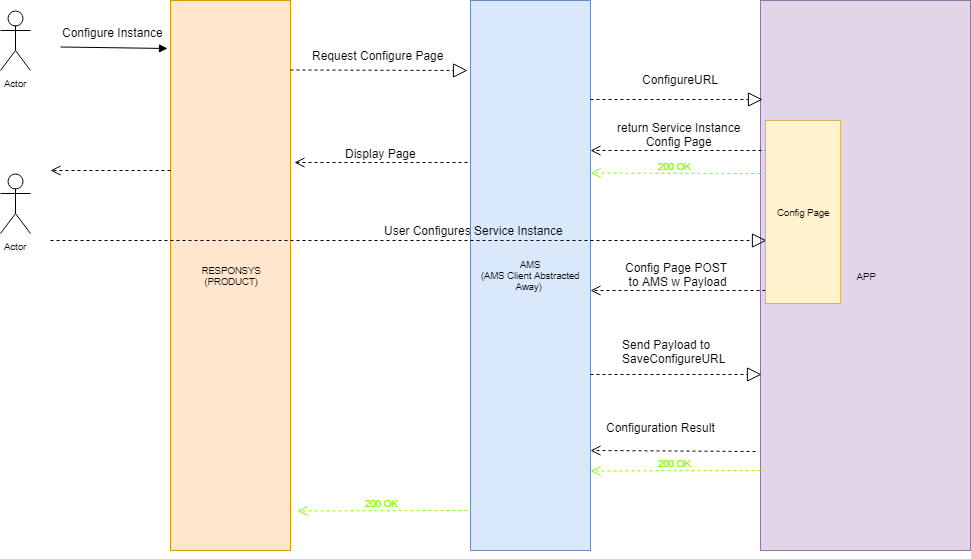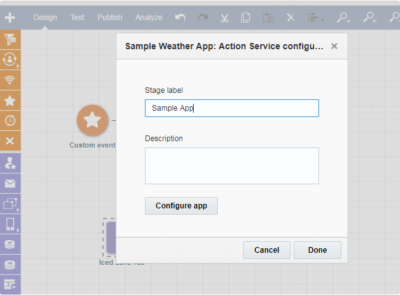Configure URL endpoint
Learn more by watching the video
Learn more by watching the video
Service Instance configuration is requested from the CX product to the app through AMS. The primary purpose of service instance configuration is to configure the app so that invocation can occur. This is a two fold process:
- The Application must provide AMS with a record definition so that AMS knows how to invoke the Application. A record definition is a set of input and output parameters so as to say that for these inputs, the app will return these outputs. This way, all parties (product, app, and AMS) understand what data will be sent and what data will be returned.
- Instance configuration allows the app to define a mapping between record definition fields (input/output parameters) to something meaningful within the app. For example, a CITY_ field in the product must be mapped to something like a City variable in the app so that the app can preform some operation with it. Both record definition and mapping configurations are done through service instance configuration.
Requirements:
- The app must provide an HTML configuration page that will be embedded within an iframe in AMS and will be displayed in the product.
- The app must implement two endpoints for service instance configuration: Configuration URL and Save Configuration URL.
Configuration Workflow
The following diagram illustrates the configuration workflow.

When a marketer configures a service instance, the Configuration URL is called. The workflow resembles these steps:
-
A marketer clicks an activity stage (the service instance) then clicks Configure app.
-
A marketer drags the template service from the widget panel into the Email Message Designer. The service's configuration is displayed within the widget panel.
- Responsys calls AMS requesting the service configuration page.
- AMS calls the service's Configuration URL to display the configuration page in Responsys.
- Marketer completes configuration and clicks save.
- AMS calls the service's Save Configuration URL.
-
The app can respond to AMS.
The content of the response should have a record definition and a configured status which could either be ERROR or CONFIGURED. Optionally, a payload can also be sent back to the application service instance configuration UI.
- AMS will display success or failure to the marketer.
Configuration URL request
AMS calls the service's Configuration URL endpoint with the following request:
POST <service-base-url><service-configuration-url>
Authorization: Bearer <JWT>
{
"uuid": "6ea036bb-8cfb-46c5-a826-d001d3a0349b",
"status": "CREATED",
"locale": "en-US",
"assetId": "23",
"assetType": "some asset"
}
Tip: The JWT Token in the Authorization Header is generated by following the AMS to App token generation. For more information about this call, including authentication details, see the endpoint API reference.
The payload will contain assetType, assetId, locale, and service instance uuid. The most important is the service instance UUID because this identifies the service instance that needs to be configured.
Apps' response to the Configuration URL request
The Configuration URL should return an HTML page that can be embedded in a iframe to be viewed from the product. It is up to the developer on the actual contents of the configuration page. There is a contract for the configuration page to postMessage to back to AMS with the results of the configuration.
When apps are loading the Configuration page there are generally two flows:
-
Apps can retrieve fields from the product (for example from Profile lists) to use during execution time for personalization
-
Apps can load a default, static page for every configuration where the user will be presented the same options for every configuration
We will walk through sample implementations for both flows.
Personalization flow - Configuration URL Sample App Code
Configuration URL Sample App Code
Below is a possible implementation of the Configuration URL endpoint. Mustache templates are used to generate HTML pages.
Sample Implementation: Configuration URL Endpoint - Controller
// ServiceInstanceController.java
@RequestMapping(value = "/configure", method=RequestMethod.POST)
public ModelAndView configureAppInstall(
@RequestBody ServiceInstanceConfigurationBodyDTO serviceInstance,
Map<String, Object> model) {
ServiceInstance instance = serviceInstanceService.getEntity(serviceInstance.getUuid());
if(instance == null) {
throw new EntityNotFoundException("Service Instance Not Found => " + serviceInstance.getUuid());
}
// Pull data from backend and use it to populate a configure template to be sent to the Product.
model.put("appHostName", hostname + port);
model.put("appInputParams", INPUT_FIELDS);
model.put("appOutputParams", OUTPUT_FIELDS);
return new ModelAndView("configure", model); //populates configure.html
}
// ServiceInstanceController.java
@RequestMapping(value = "/configure", method=RequestMethod.POST)
public ModelAndView configureAppInstall(
@RequestBody ServiceInstanceConfigurationBodyDTO serviceInstance,
Map<String, Object> model) {
ServiceInstance instance = serviceInstanceService.getEntity(serviceInstance.getUuid());
if(instance == null) {
throw new EntityNotFoundException("Service Instance Not Found => " + serviceInstance.getUuid());
}
// Pull data from backend and use it to populate a configure template to be sent to the Product.
// The following parameters may be used by the app for future requests (ie. the Summary call or Get Template call)
model.put("appHostName", hostname + port);
model.put("Params1",FIELDS);
model.put("Params2",FIELDS);
return new ModelAndView("configure", model); //populates configure.html
}
Sample Implementation: Configuration URL Endpoint - UI
// configure.html - populated from java code and sent back to AMS.
// creates something like City -> CITY_ (Product Field)
// Country -> COUNTRY_ (Product Field)
// Humidity -> HUMIDITY_ (Product Field)
<h4 id="input-map-title">Select Input Parameters Mappings</h4><ul>
{{#appInputParams}}
<div class="row">
<h4>{{.}} => </h4>
<select id="{{.}}" name="{{.}}">
<option value="" selected disabled hidden>Choose a Product Field</option>
</select>
</div>
{{/appInputParams}}</ul>
// configure.html - populated from java code and sent back to AMS.
// creates something like Customer ID -> Customer Name (Product Field)
<h4 id="input-map-title">Select Fields</h4><ul>
{{#appInputParams}}
<div class="row">
<h4>{{.}} => </h4>
<select id="{{.}}" name="{{.}}">
<option value="" selected disabled hidden>Choose a Product Field</option>
</select>
</div>
{{/appInputParams}}</ul>
Field Metadata Endpoint (fieldMetadataEndpoint)
The contract between the product and the app regarding the fields available on the product is defined by a product's fieldMetadataEndpoint. i.e. In order to find the fields for an entity (ie. a contact), the product must provide a public endpoint that the app can query to find the fields for an entity such as a contact. This endpoint is sent to AMS by the product and is saved as METADATA.fieldMetadataEndpoint.url in the AMS iframe. To get this, the configuration page can request the metadata via postMessage with an amsAction="metadata".
The metadata postMessage should resemble:
{
amsAction: 'metadata'
}
The metadata postMessage returns a payload in the AMS iframe. This payload resembles:
{
metadata: {
fieldMetadataEndpoint: {
url: "https://www.rsys.com/somethingvalid",
method: "GET"
}
}
}
Using the information from this payload, the app can now request for the fields to build the record definition for each service instance via the product postMessage (amsAction="product").
Using the information from this payload, the app can now request for the fields for each service instance via the product postMessage (amsAction="product").
The product postMessage should resemble:
{
amsAction: 'product',
requestId: 'dfd33125-6923-4467-b659-97a174de5801'
destinationUrl: metadata.fieldMetadataEndpoint.url,
requestType: metadata.fieldMetadataEndpoint.method,
payload: {}
}
The response payload resembles:
{
statusCode: 200,
requestId: "dfd33125-6923-4467-b659-97a174de5801",
payload: "{
"objects": [
{
"name": "!!!!DM630",
"type": "Standard",
"fields": [
{
"name": "RIID_",
"dataType": "Text",
"width": 0,
"readOnly": true,
"format": null
},
{
"name": "CREATED_SOURCE_IP_",
"dataType": "Text",
"width": 255,
"readOnly": true,
"format": null
},
{
"name": "CUSTOMER_ID_",
"dataType": "Text",
"width": 255,
"readOnly": true,
"format": null
}
]
}]
}"
}
Static flow - Configuration URL Sample App Code
Alternatively apps may want to display a static configuration page for marketers to configure specific fields. The fields could then be configured and used throughout the app's lifecycle for subsequent calls such as the Get Template URL.
Example: Apps could ask the user to specify an image URL and link URL during configuration. Later in the app's lifecycle when the Get Template URL is called, the response could return HTML where a clicking an image takes marketers to a web page.
Configure Page postMessage to AMS
Once the user has finished entering input (ie. the customer ID) and clicks save, the app should listen to the postMessage from the parent iframe, which would be AMS. Refer to Configuration iframes to learn more about how you can save the configuration or close the configuration window.
Configure Page postMessage listener for Save Configuration URL
The configure page must also implement a listener for the response of the Save Configuration URL. This is to display configuration success or failure to the user.
Sample Implementation: Configure page postMessage listener
attachMessageListener() {
var messageHandlerFunction = this.handleMessage.bind(this);
window.addEventListener("message", messageHandlerFunction, false);
}
handleMessage(event) {
if(event && event.data) {
console.log("Received Event From AMS", event);
var data = event.data;
if(data.requestId == this.amsAction || data.configurationStatus){
this.receivedMessage = true;
var response = this.parseResponse ? this.parseResponse(data) : data;
this.handleMessageResponse(response);
}
}
}
Save Configuration URL endpoint
This endpoint is called when a marketer saves the configuration of the template service app in the Configuration.
After the user has finished configuring the service instance, AMS will POST to the service's Save Configuration URL endpoint with the results from the user's configuration. The purpose of this endpoint is to take the configuration that the user has set and save it within the app. When AMS POSTs to the service's Save Configuration URL endpoint, the payload includes:
- An
instanceUuid. Used to tie the configuration changes with the service instance. - (Optional) A
payload. Can be of any form chosen by the app developer. The content sent in postMessage from configure page.
AMS calls the service's Save Configuration URL endpoint with the following request:
POST <service-base-url><service-saveconfiguration-url>
Authorization: Bearer <JWT>
{
"instanceUuid": "6ea036bb-8cfb-46c5-a826-d001d3a0349b",
"payload": {
//Definedbydeveloper.WhateverissentinpostMessagefromConfigurePage.
}
}
Apps' response to the Save Configuration URL request
This endpoint should return the configuration status, status code, and any record definitions. In the sample code we are returning an AppConfigurationChangeStatusDTO object to AMS.
This endpoint should return the configuration status and status code. In the sample code we are returning an AppConfigurationChangeStatusDTO object to AMS.
Save Configuration URL payload response to AMS
{
"configurationStatus": "CONFIGURED",
"payload": {},
"httpStatusCode": "200",
"recordDefinition": {
"inputParameters": [
{
"name": "appcloud_row_correlation_id",
"dataType": "Text",
"width": 40,
"unique": true,
"required": true,
"readOnly": null,
"minimumValue": null,
"maximumValue": null,
"possibleValues": null,
"format": null,
"resources": null
},
...
],
"outputParameters": [
{
"name": "appcloud_row_correlation_id",
"dataType": "Text",
"width": 40,
"unique": true,
"required": true,
"readOnly": null,
"minimumValue": null,
"maximumValue": null,
"possibleValues": null,
"format": null,
"resources": null
}
...
]
}
}
{
"configurationStatus": "CONFIGURED",
"payload": {},
"httpStatusCode": "200"
}
Sample Implementation: Save Configuration URL Endpoint
@RequestMapping(value = "/saveConfigure", method=RequestMethod.POST)
public AppConfigurationChangeStatusDTO saveConfigureAppInstall( @RequestBody String body) throws JSONException, IOException {
....
// What we are doing in essence.
serviceInstance.setCity(payload.getString(CITY_FIELD_NAME));
serviceInstance.setCountry(payload.getString(COUNTRY_FIELD_NAME));
...
AppConfigurationChangeStatusDTO status = new AppConfigurationChangeStatusDTO();
status.setRecordDefinition(definition);
status.setConfigurationStatus(AppConfigurationStatusType.CONFIGURED);
return status;
}
Sample Implementation: AppConfigurationChangeStatusDTO
// AppConfigurationChangeStatusDTO.java
public class AppConfigurationChangeStatusDTO {
private RecordDefinitionDTO recordDefinition;
private AppConfigurationStatusType configurationStatus;
private Object payload;
}
AMS postMessage to Configuration Page
AMS would then postMessage the same response to the listener in the configuration page with the results of the Save Configuration URL. This is so the page can update itself and inform the user of the configuration result.
AMS postMessage example to configuration page
{
"requestId": "be446dc2-8f30-4fd7-95bb-c72bacff5ebf",
"configurationStatus": "CONFIGURED",
"payload": {},
"httpStatusCode": "200",
"recordDefinition": {
"inputParameters": [
{
"name": "appcloud_row_correlation_id",
"dataType": "Text",
"width": 40,
"unique": true,
"required": true,
"readOnly": null,
"minimumValue": null,
"maximumValue": null,
"possibleValues": null,
"format": null,
"resources": null
},
...
],
"outputParameters": [
{
"name": "appcloud_row_correlation_id",
"dataType": "Text",
"width": 40,
"unique": true,
"required": true,
"readOnly": null,
"minimumValue": null,
"maximumValue": null,
"possibleValues": null,
"format": null,
"resources": null
}
...
]
}
}
{
"requestId": "be446dc2-8f30-4fd7-95bb-c72bacff5ebf",
"configurationStatus": "CONFIGURED",
"payload": {},
"httpStatusCode": "200"
}


